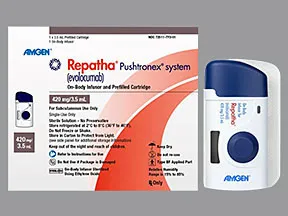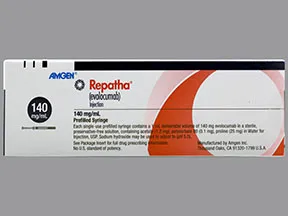Dosing & Uses
Dosage Forms & Strengths
solution for SC injection
- 140mg/mL single-use SureClick autoinjector
- 140mg/mL single-use prefilled syringe (to be discontinued mid-2025)
- 420mg/3.5mL single-use Pushtronex system; on-body infusor with prefilled cartridge (to be discontinued June 30, 2024)
Prevention of Cardiovascular Events
Indicated to reduce the risk of myocardial infarction, stroke, and coronary revascularization
140 mg SC q2weeks OR 420 mg SC once monthly, based on patient preference for dosing frequency and injection volume
When switching dosage regimens, administer first dose of new regimen on the next scheduled date of the prior regimen
Primary Hyperlipidemia
Adjunct to diet, alone or in combination with other lipid-lowering therapies (eg, statins), for treatment of primary hyperlipidemia, including heterozygous familial hyperlipidemia (HeFH), to reduce LDL-C
140 mg SC q2weeks or 420 mg SC once monthly
When switching dosage regimens, administer first dose of new regimen on the next scheduled date of the prior regimen
Homozygous Familial Hypercholesterolemia
Indicated as an adjunct to other LDL-lowering therapies in patients with homozygous familial hypercholesterolemia (HoFH), to reduce LDL-C
420 mg SC once monthly
May increase to 420 mg q2Weeks if a clinically meaningful response not achieved in 12 weeks
Patients on lipid apheresis may initiate treatment with 420 mg q2Weeks to correspond with apheresis schedule; administer evolocumab after completing apheresis session
Dosage Modifications
Renal impairment
- Mild or moderate: No dose adjustment required
- Severe or end-stage renal disease (ESRD): In a clinical trial, reductions in PCSK9 levels in patients with severe renal impairment or ESRD receiving hemodialysis was similar to those with normal renal function
Hepatic impairment
- Mild or moderate: No dose adjustment required
- Severe: No data available
Dosing Considerations
HoFH
- Assess LDL-C when clinically appropriate; LDL-lowering effects may be measured as early as 4 weeks after initiation
- Once-monthly dosing: Note that LDL-C can vary during dosing interval in some patients; recommend measuring LDL-C just before next scheduled dose
Dosage Forms & Strengths
SC injection
- 140mg/mL single-use SureClick autoinjector
- 140mg/mL single-use prefilled syringe (to be discontinued mid-2025)
- 420mg/3.5mL single-use Pushtronex system; on-body infusor with prefilled cartridge (to be discontinued June 30, 2024)
Heterozygous Familial Hypercholesterolemia
Indicated as an adjunct to diet and other LDL-lowering therapies (eg, statins, ezetimibe, LDL apheresis) for the treatment of children aged ≥10 years with heterozygous familial hypercholesterolemia (HeFH) who require additional LDL-C reduction
<10 years: Safety and efficacy not established
10-17 years
- 140 mg SC q2weeks or 420 mg SC once monthly
- When switching dosage regimens, administer first dose of new regimen on the next scheduled date of the prior regimen
Homozygous Familial Hypercholesterolemia
Indicated as an adjunct to diet and other LDL-lowering therapies (eg, statins, ezetimibe, LDL apheresis) for the treatment of children aged ≥10 years with homozygous familial hypercholesterolemia (HoFH) who require additional lowering of LDL-C
<10 years: Safety and efficacy not established
10-17 years
- Initial: 420 mg SC once monthly
- May increase to 420 mg q2Weeks if a clinically meaningful response not achieved in 12 weeks
- Patients on lipid apheresis may initiate treatment with 420 mg q2Weeks to correspond with apheresis schedule; administer evolocumab after completing apheresis session
Dosing Considerations
HoFH
- Assess LDL-C when clinically appropriate; LDL-lowering effects may be measured as early as 4 weeks after initiation
- Once-monthly dosing: Note that LDL-C can vary during dosing interval in some patients; recommend measuring LDL-C just before next scheduled dose
Adverse Effects
>10%
Nasopharyngitis (4-10.5%)
1-10%
Upper respiratory tract infection (2.1-9.3%)
Influenza (1.2-7.5%)
Back pain (2.3-6.2%)
Injection site reactions (3.2-5.7%)
Allergic reaction (5.1%)
Cough (1.2-4.5%)
Urinary tract infection (1.3-4.5%)
Sinusitis (4.2%)
Headache (4%)
Myalgia (4%)
Dizziness (3.7%)
Musculoskeletal pain (3.3%)
Hypertension (3.2%)
Diarrhea (3%)
Gastroenteritis (3%)
Arthralgia (1.8%)
Nausea (1.8%)
Fatigue (1.6%)
Muscle spasms (1.3%)
Contusion (1%)
Oropharyngeal pain (7%)
Postmarketing Reports
Allergic reactions: Angioedema
Warnings
Contraindications
History of serious hypersensitivity to evolocumab or any excipients
Cautions
Hypersensitivity
- Hypersensitivity reactions (eg, angioedema) reported, including some that led to discontinuation of therapy
- If signs or symptoms of serious allergic reactions occur, discontinue treatment, treat accordingly and monitor until signs and symptoms resolve
- Needle cover of glass single-dose prefilled syringe and single-dose prefilled autoinjector contain dry natural rubber (latex derivative) which may cause an allergic reaction in individuals sensitive to latex
Pregnancy
Pregnancy
No available data on use in pregnant women
Monoclonal antibodies in humans indicate that they are unlikely to cross the placenta in the first trimester; however, they are likely to cross the placenta in increasing amounts in the second and third trimesters
There is a pregnancy safety study for REPATHA; if administered during pregnancy, healthcare providers should report exposure by contacting Amgen at 1-800-77-AMGEN (1-800-772-6436) or https://wwwext.amgen.com/products/global-patient-safety/adverse-event-reporting
Animal studies
- No effects on pregnancy or neonatal/infant development when monkeys were subcutaneously administered evolocumab from organogenesis through parturition at dose exposures up to 12 times the exposure at the maximum recommended human dosage
- In a similar study with another drug in the PCSK9 inhibitor antibody class, humoral immune suppression was observed in infant monkeys exposed to that drug in utero at all doses
Lactation
Unknown if distributed in human breast milk
The development and health benefits of breastfeeding should be considered along with the mother’s clinical need for the drug and any potential adverse effects on the breastfed infant
Human IgG is present in human milk, but published data suggest that breastmilk IgG antibodies do not enter the neonatal and infant circulation in substantial amounts
Pregnancy Categories
A: Generally acceptable. Controlled studies in pregnant women show no evidence of fetal risk.
B: May be acceptable. Either animal studies show no risk but human studies not available or animal studies showed minor risks and human studies done and showed no risk. C: Use with caution if benefits outweigh risks. Animal studies show risk and human studies not available or neither animal nor human studies done. D: Use in LIFE-THREATENING emergencies when no safer drug available. Positive evidence of human fetal risk. X: Do not use in pregnancy. Risks involved outweigh potential benefits. Safer alternatives exist. NA: Information not available.Pharmacology
Mechanism of Action
Monoclonal antibody that binds to PCSK9 (proprotein convertase subtilisin/kexin type 9)
LDL-C is cleared from the circulation preferentially through the LDL receptor (LDLR) pathway
PCSK9 is a serine protease that destroys LDLR in the liver, resulting in decreased LDL-C clearance and increased plasma LDL-C
PCSK9 inhibitors decrease LDLR degradation by PCSK9, and thereby improve LDL-C clearance and lower plasma LDL-C
Absorption
Bioavailability: 72%
Peak plasma time: 3-4 days
Peak plasma concentration: 18.6 mcg/mL (140 mg); 59 mcg/mL (420 mg)
AUC (last): 188 day·mcg/mL (140 mg); 924 day·mcg/mL (420 mg)
Distribution
Vd: 3.3 L (420 mg)
Metabolism
At low concentrations: Elimination is predominately through saturable binding to target, PCSK9
At higher concentrations: Elimination of evolocumab is largely through a nonsaturable proteolytic pathway
Elimination
Half-life: 11-17 days
Administration
SC Preparation
Advise latex-sensitive patients that needle cover of the glass single-dose prefilled syringe and the single-dose prefilled autoinjector contain dry natural rubber (a derivative of latex)
Remove prescribed dose from refrigerator at least 30 minutes (prefilled autoinjector or syringe) or 45 minutes (on-body infusor) before administration; this helps administer the entire dose and minimizes injection discomfort
Do not heat syringe, autoinjector, or on-body infusor (eg, microwave or hot water); let them warm to room temperature on their own
Do not leave in direct sunlight; keep in original carton until administered
Do not use autoinjector or on-body infusor if
- Drug appears cloudy or discolored, or contains particles
- Device appears cracked or broken
- The device has been dropped
- The orange cap is missing or not securely attached
SC Administration
Available as 140-mg/mL prefilled syringe or autoinjector; also available as 420-mg/3.5-mL on-body infusor
420 mg dose: Give three 140-mg SC injections consecutively within 30 minutes OR over 5 minutes using the single-use on-body infusor with refilled cartridge
Clean injection site with alcohol wipe and let dry
Do not inject in areas of skin that are bruised, red, tender, or hard
Avoid injecting in scars or stretch marks
Rotate administration sites
See prescribing information for images depicting injection technique for the various devices
Administration sites
- Self-injection: Thigh or abdomen (except for a 2-inch area around the naval)
- Caregiver: Thigh, abdomen, or outer area of upper arm
Missed dose
- Dose missed within 7 days: Administer dose and start a new schedule based on this date
-
Dose not administered within 7 days
- 140 SC q2week dose: Wait until the next dose on the original schedule
- 420 mg SC once monthly: Administer dose and start a new schedule based on this date
Storage
Refrigerate at 2-8°C (36-46°F) in the original carton
Alternatively, may store at room temperature (20-25°C [68-77°F]) in the original carton; however, under these conditions, drug must be used within 30 days; if not used within the 30 days, discard
Protect from direct light
Do not expose to temperatures >25°C (77°F)
Do not shake
Images
| BRAND | FORM. | UNIT PRICE | PILL IMAGE |
|---|---|---|---|
| Repatha Pushtronex subcutaneous - | 420 mg/3.5 mL kit |  | |
| Repatha SureClick subcutaneous - | 140 mg/mL injection |  | |
| Repatha Syringe subcutaneous - | 140 mg/mL solution |  |
Copyright © 2010 First DataBank, Inc.
Formulary
Adding plans allows you to compare formulary status to other drugs in the same class.
To view formulary information first create a list of plans. Your list will be saved and can be edited at any time.
Adding plans allows you to:
- View the formulary and any restrictions for each plan.
- Manage and view all your plans together – even plans in different states.
- Compare formulary status to other drugs in the same class.
- Access your plan list on any device – mobile or desktop.






